


 |
University Campuses
Highbridge staff has been involved with materials investigations and quality assurance at Boston College since 2006. Our clients (McGinley Kalsow & Associates and Building and Monument Conservation) involved us in the initial phases of the site investigation in order to characterize cast stone failures at Gasson Hall, the flagship building at Boston College. Our failure analyses were used to inform a bold restoration plan for Gasson Hall including the design of replacement cast stone masonry true to the original aesthetic but better designed to withstand years of exposure. Our current role comprises the quality control of the restoration materials including freeze-thaw durability testing, petrography, air-void analysis, compressive strength and absorption testing of replacement cast stone. |
|
 |
Religious Institutions
Though only a small part of the project team led by Building Conservation Associates, Highbridge staff was entrusted with the characterization of a range of materials used in the construction of St. Patrick’s Cathedral in New York. Our petrographers were tasked with identifying the constituents of cast stone masonry, stone mortar, and plaster discovering a range of historical cements, limes, and gypsum-based binders. Our chemist using a combination of wet chemical techniques and atomic absorption spectroscopy effectively deconstructed each sample in order to reverse engineer the constituent proportions in addition to characterizing the chemistry of the original binders. |
|
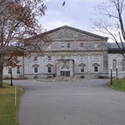 |
Government Buildings
Rideau Hall in Ottawa is the official residence of the Governor General of Canada. Our work involved petrographic examination and chemical analysis of exterior stuccoes from construction and repair campaigns from the late 19th century to the 1950’s. Estimation of cement to lime ratios were used to understand the permeability characteristics and other performance characteristics of the building envelope. Identification of hydraulic limes and pre-rotary kiln cements assisted in establishing approximate dates of construction. Observations of microscopic veneers and weathering profiles revealed original exposure characteristics underneath later coating applications. |
|
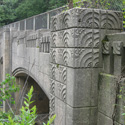 |
Infrastructure
The Merritt Parkway in Connecticut is one of the oldest toll roads in the United States. Unique cast-in-place concrete bridges were designed by architect George L. Dunkelberger in the 1930’s each with a different design. As part of an extensive cleaning, repair and rehabilitation program begun in 2009, Highbridge was enlisted to accurately document the concrete mix design for each of twelve historic bridges. In addition to determining cement contents and aggregate characteristics, carbonation depths and water-soluble chloride contents were determined in preparation for any coating applications as well as understanding corrosion susceptibility for embedded steel. |
|
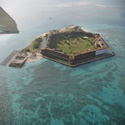 |
Military Fortifications
Highbridge staff has extensive experience in the history of materials usage in American coastal fortifications as well as lighthouses. Analysis of these structures requires both an understanding of the materials as well as their performance characteristics in coastal and subaqueous environments. Of the many forts and lighthouses on which we have had the privilege to work, Fort Jefferson in the Dry Tortugas represents our most sustained project spanning the course of seven years. The opportunity has allowed us to demonstrate how analysis should be tailored to the specific materials used rather than applying turnkey methodologies. The approach has aided in a relatively simple but more accurate interpretation of the building’s history and performance consistent with both historical documentation and the present day condition of the structure. |
|
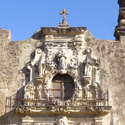 |
Fine Art Conservation
As part of a preliminary survey of intricately carved limestone sculptures at the 18th century Mission San Jose in San Antonio, Highbridge was tasked with characterizing the stone and investigating possible distress mechanisms causing contour cracking of the carved surfaces. Understanding stone decay in sculptural work requires a firm grounding in geology along with an ability to generate maximum data from minimal sample sets. Careful chemical analysis indicated an absence of salt concentrations that might have been a likely root cause. Instead, petrographic examination of the limestone revealed trace minerals including original glauconite within microscopic fossil shells that have since altered to combinations of iron oxides and swelling clays. |
|
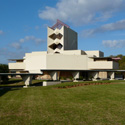 |
Prominent Architects
To a materials scientist, architects’ legacies are found as clearly in the materials used as well as their unique designs. Frank Lloyd Wright is perhaps one of the most interesting to a forensic petrographer. His detailed specifications reveal an experimental spirit in materials design and both successes and failures are often traced to his novel approach. Additionally, comparison of installed products to original mix designs often reveals significant deviations on the part of the builders. Our most recent Frank Lloyd Wright project is the Annie Pfeiffer Chapel, one of the original textile block buildings on the Florida Southern College campus in Lakeland, FL. Our studies have included petrographic examination of block constituents and chemical estimates of proportions as they relate to durability of the historic block. |